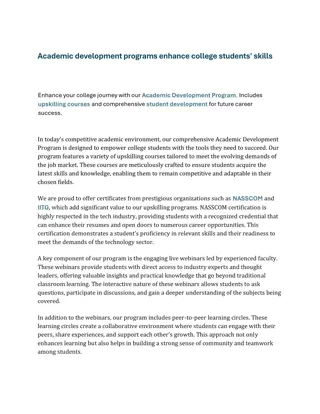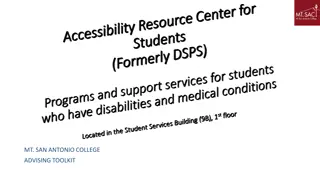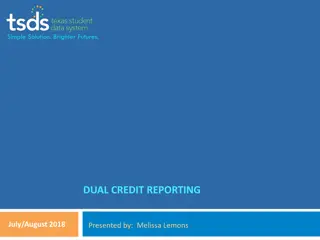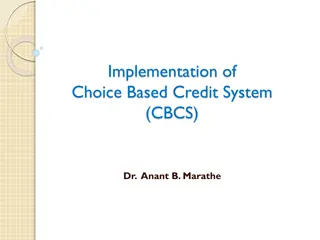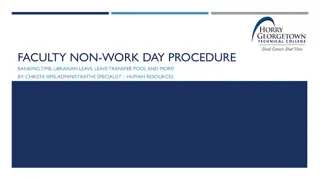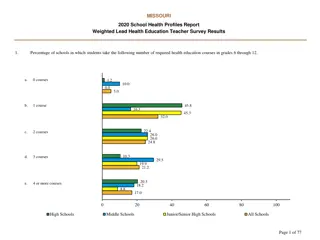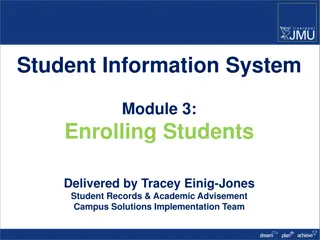Understanding Student Work Hours in Academic Courses
Learn about the different types of hours involved in academic courses, including contact hours, outside-of-class hours, and total student learning hours. Discover how these hours are calculated for credit courses, lectures, labs, and activities, with sample calculations provided for a better understanding.
Download Presentation

Please find below an Image/Link to download the presentation.
The content on the website is provided AS IS for your information and personal use only. It may not be sold, licensed, or shared on other websites without obtaining consent from the author. Download presentation by click this link. If you encounter any issues during the download, it is possible that the publisher has removed the file from their server.
E N D
Presentation Transcript
Hours on COR Contact Hours Hours that students are in direct contact with the instructor. Used to calculate FTES and apportionment Outside of Class Hours Hours the student is expected to work on classwork outside of the classroom Hours of Total Student Work Contact Hours plus Outside of Class Hours
Credit Courses: Standard Calculation Units of Credit = [Total Contact Hours + Outside-of-class Hours] Hours-per-unit Divisor Hours per unit divisor is the total hours of student work needed to earn 1 unit of credit. For us this is 54 hours. Round down to the nearest increment awarded by the college.
Lecture Defined as an academic activity that involves lecture, discussion, seminar, or related work that assumes two hours of outside class work for every one hour of contact in class. 1 Unit = 18 Lecture Hours Lecture Hours * 2 = Homework Hours Contact Hours + Homework Hours = Total Student Learning Hours Units Contact Hours Homework Total Student Learning Hours Hours 1 18 36 54 2 36 72 108 3 54 108 162
Lab Defined as an academic activity that involves traditional lab, clinical, activity, or related work that assumes zero hours of outside class work for every one hour of contact in class. 1 Unit = 54 Lab Hours Lab Hours * 0 = Homework Hours Contact Hours + Homework Hours = Total Student Learning Hours Units Contact Hours Homework Total Student Learning Hours Hours 1 54 0 54 2 108 0 108 3 162 0 162
Activity Defined as an academic activity that involves activity, lab with homework, studio, or similarly related work that assumes one hour of outside class work for every two hours of contact in class. Consists of any combination of lecture/lab hours. 1 Unit = 36 Contact Hours (combination of Lecture and Lab) Contact Hours * 1/2 = Homework Hours (Lecture * 2 + Lab * 0) Contact Hours + Homework Hours = Total Student Learning Hours Units Contact Hours Homework Total Student Learning Hours Hours 1 36 18 54 2 72 36 108 3 108 54 162
Sample Calculations Contact Hours Total Student Learning Hours Example Course Type All examples use 54 hours = 1 unit Outside-of- class Hours Lecture Hours Activity Laboratory Other Units 54 0 0 0 108 162 3 Traditional Lecture Course #1 72 0 0 0 144 216 4 Traditional Lecture Course #2 0 0 108 0 0 108 2 Traditional Lab Course #1 0 0 162 0 0 162 3 Traditional Lab Course #2 0 0 175 0 0 175 3 Lab Course #1 0 0 980 0 0 980 18 Lab Course #2 0 0 40 0 0 40 0.5 Lab Course #3 0 72 0 0 36 108 2 Activity Course #2 0 108 0 0 54 162 3 Activity Course #3 54 0 54 0 108 216 4 Lecture / Laboratory Course #1 36 0 72 0 72 180 3 Lecture / Laboratory Course #2 27 0 81 0 54 162 3 Lecture / Laboratory Course #3 36 36 0 0 90 162 3 Lecture / Activity Course #1 27 0 54 18 54 162 3 Lecture / Laboratory / TBA Source: ASCCC 2018 Curriculum Institute: All About the Credit Hour (Slide 25)
Other Considerations Clock Hour Programs 1 Unit = 37.5 Hours Cooperative Work Experience 1 Unit = 75 Hours of Paid Work Experience 1 Unit = 60 Hours of Unpaid Work Experience Nursing Specific requirements on hours and units Non-Credit Outside of class hours is zero






